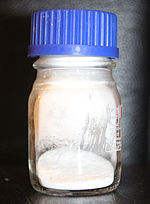https://www.theatlantic.com/health/archive/2016/10/the-era-when-poison-was-everywhere/503654/

https://www.theatlantic.com/health/archive/2016/10/the-era-when-poison-was-everywhere/503654/

https://nineteenteen.blogspot.com/2015/11/death-and-dyeing.html

A sesquioxide is an oxide of an element (or radical), where the ratio between the number of atoms of that element and the number of atoms of oxygen is 2:3. For example, aluminium oxide Al2O3 and phosphorus(III) oxide P4O6 are sesquioxides. Many sesquioxides contain a metal in the +3 oxidation state and the oxide ion O2−, e.g., aluminium oxide Al2O3, lanthanum(III) oxide La2O3 and iron(III) oxide Fe2O3. Sesquioxides of iron and aluminium are found in soil. The alkali metal sesquioxides are exceptions because they contain both peroxide O2−2 and superoxide O−2 ions, e.g., rubidium sesquioxide Rb4O6 is formulated (Rb+)4(O2−2)(O−2)2.[1] Sesquioxides of metalloids and nonmetals are exceptions too, e.g. boron trioxide B2O3, dinitrogen trioxide N2O3 and phosphorus(III) oxide P4O6.
Many transition metal oxides crystallize in the corundum structure type, with space group R3c. Sesquioxides of rare earth elements crystalize into one or more of three crystal structures: hexagonal (type A, space group P3m1), monoclinic (type B, space group C2/m), or body-centered cubic (type C, space group Ia3).[2][3]
Sesquioxidizing, meaning the creation of a sesquioxide, is the highest scoring word that would fit on a Scrabble board,[4] though it does not actually appear in any official Scrabble dictionary.[5] Though the Oxford English Dictionary already listed the noun and the past participle adjective — sesquioxidation and sesquioxidized, respectively — the verb, sesquioxidize, and its conjugated forms, have been absent from the dictionaries used as sources for the official Scrabble word lists. An early appearance of the noted present participle had occurred in the 1860 publication of the State of New York's Legislative Assembly's Transactions of the State Medical Society,[6] yet the word's first appearance in a dictionary was in the 1976 edition of Josepha Heifetz Byrne's Mrs. Byrne's Dictionary of Unusual, Obscure, and Preposterous Words (ISBN 0806504986),[7] One could theoretically score 2044 points in a single move, when otherwise only words from the official Scrabble word list are used.[8]
https://en.wikipedia.org/wiki/Sesquioxide
| |||

| |||
| Names | |||
|---|---|---|---|
| Other names
Diphosphorus pentoxide
Phosphorus(V) oxide Phosphoric anhydride Tetraphosphorus decaoxide Tetraphosphorus decoxide | |||
| Identifiers | |||
| |||
3D model (JSmol)
|
| ||
| ChEBI | |||
| ChemSpider | |||
| ECHA InfoCard | 100.013.852 | ||
PubChem CID
|
|||
| RTECS number |
| ||
| UNII | |||
CompTox Dashboard (EPA)
|
|||
| Properties | |
|---|---|
| P4O10 | |
| Molar mass | 283.9 g mol−1 |
| Appearance | White powder Very deliquescent |
| Odor | Odorless |
| Density | 2.39 g/cm3 |
| Melting point | 340 °C (644 °F; 613 K) |
| Boiling point | 360 °C (sublimes) |
| exothermic hydrolysis | |
| Vapor pressure | 1 mmHg @ 385 °C (stable form) |
| Hazards | |
| Occupational safety and health (OHS/OSH): | |
Main hazards
|
reacts with water, strong dehydrating agent, corrosive |
| NFPA 704 (fire diamond) | |
| Safety data sheet (SDS) | MSDS |
Except where otherwise noted, data are given for materials in their standard state (at 25 °C [77 °F], 100 kPa).
| |
Phosphorus pentoxide is a chemical compound with molecular formula P4O10 (with its common name derived from its empirical formula, P2O5). This white crystalline solid is the anhydride of phosphoric acid. It is a powerful desiccant and dehydrating agent.
https://en.wikipedia.org/wiki/Phosphorus_pentoxide
Arsenic trioxide can be generated via routine processing of arsenic compounds including the oxidation (combustion) of arsenic and arsenic-containing minerals in air. Illustrative is the roasting of orpiment, a typical arsenic sulfide ore.
Most arsenic oxide is, however, obtained as a volatile by-product of the processing of other ores. For example, arsenopyrite, a common impurity in gold- and copper-containing ores, liberates arsenic trioxide upon heating in air. The processing of such minerals has led to numerous cases of poisonings,[18] and after the mine is closed, the leftover trioxide waste will present environmental hazard (as was the case with the Giant Mine, for example). Only in China are arsenic ores intentionally mined.[9]
In the laboratory, it is prepared by hydrolysis of arsenic trichloride:[19]
As
2O
3 occurs naturally as two minerals, arsenolite (cubic) and claudetite (monoclinic). Both are relatively rare secondary minerals found in oxidation zones of As-rich ore deposits. Sheets of As2O3 stand for part of structures of the recently discovered minerals lucabindiite, (K,NH4)As4O6(Cl,Br),[20] and its sodium-analogue torrecillasite.[21]
https://en.wikipedia.org/wiki/Arsenic_trioxide

Industrial uses include usage as a precursor to forestry products, in colorless glass production, and in electronics.[9] Being the main compound of arsenic, the trioxide is the precursor to elemental arsenic, arsenic alloys, and arsenide semiconductors. Bulk arsenic-based compounds sodium arsenite and sodium cacodylate are derived from the trioxide.[citation needed]
A variety of applications exploit arsenic's toxicity, including the use of the oxide as a wood preservative. Copper arsenates, which are derived from arsenic trioxide, are used on a large scale as a wood preservative in the U.S. and Malaysia, but such materials are banned in many parts of the world. This practice remains controversial.[9] In combination with copper(II) acetate, arsenic trioxide gives the vibrant pigment known as Paris green used in paints and as a rodenticide. This application has been discontinued.[citation needed]
https://en.wikipedia.org/wiki/Arsenic_trioxide